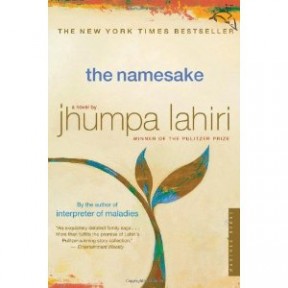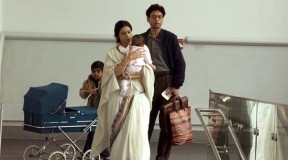We were walking down the streets of the busiest city this side of the Atlantic. There was paper everywhere – in the windows of old, battered-down bookshops and on the unbalanced tables of the street vendors selling novels in languages that were foreign to my ears. There were flyers about missing dogs and moving sales stapled into telephone poles and advertisements placed strategically in that area of the windshield that you can never reach so you can’t ignore them. There were soggy newspapers left one too many days outside on the front step and somewhere, in the midst of all the ink and paper, there was a book.
At first glance, there was nothing especially unique about this book. It had a cover, back and front, age-worn and yellowed pages, scribbles of crayon and black pen on the inside front cover and The Namesake printed on the binding. In all honesty, I do not know what compelled me to pick it up. I could blame it on some supernatural force moving my attention to the right spot at the right time, but most likely it was more an act of sheer boredom coupled with a hint of rebellion when my mother said not to touch it.
It could also have been the title. Two years ago, while flying through London on my way back from a summer vacation spent in India, I stood behind an older lady during the security check. She had in one arm a baby and in the other held a book open to read as we waited. While we all stood complaining about the ridiculousness of making us leave the plane only to get back into it after two hours of waiting in line, the lady stood silently, gently cooing to her child while reading this book. When the two finally arrived at the security check, the guard confiscated the book and the baby’s stuffed animals “for security measures.” For the first time, the lady spoke, questioning the validity of the idea that a bomb or a knife could be placed within the creased corners of her novel or in the soft fur of the baby’s stuffed tiger. When my novel followed suit, I watched it land on top of the lady’s book. The Namesake, the title read.
So, two years later, while meandering down the streets of Manhattan, I saw the title and stopped for a second, processing for a moment where I had seen this before and then stooping to pick it up. There was a second of the irrational idea that maybe this was that very same copy that lady gave up that day at the airport. The pages were slightly wet from the dew of the morning and the ink from the board propped behind it (“books for free”) had bled onto the back cover. Otherwise, though, the book was completely intact and well-worn as only a well-read book can be.
I won’t lie and say that, as soon as my hands touched the cover, I felt some deep, hidden magical connection telling me this book would change my life forever. In fact, the book was thrown into my closet when I got back home and was never to be seen again until months later, when I had exhausted the Internet and my bookshelf and was looking for something new. Even after I began reading it, there were no fireworks in my mind or moments of utter clarification and I didn’t begin it expecting any epiphanies. Like any other book, I simply picked it up and read it.
It was the story of an immigrant family that travelled to America, similar to the story of my own parents and of countless other Indian immigrants in America. It was the story of two generations stuck between two conflicting cultures. It told of Nikhil ‘Gogol’ Ganguli, an awkward child who grew up to be insecure in his identity as an Indian-American with a Russian name. It was a coming-of-age story that spanned over 50 years, beginning with the father and continuing with the son as he searches for his identity.
As the story unfolds, you watch the son’s transition from an Indian son (who defines himself by what his family has made him) to an American adult, no longer comfortable in the skin he’s in. You watch him fall apart and pick himself back up. You witness his struggles to reconcile two cultures that have contradictory ideas. You experience his tragedies, his faults, his flaws and condemn him for his actions. You watch him turn his back on his family and then on the world and finally, you watch him learn how to let go of his past and move on with his future as the product of two worlds.
The book provides solace to every Indian-American child who has grown up cringing when teachers attempt their name for the first time. It provides consolation to every immigrant teenager, unsure of whether or not the morals of their family are something they could carry with in the coming years. It assures Indian-American families that becoming assimilated doesn’t mean changing everything you believe in. It shows the sons and daughters of two conflicting worlds that it is a boon, not a curse, to have two ways to think.
I am Indian-American. I have grown up with dark skin and dark hair and a name that nobody pronounces correctly. Like Gogol, I have felt the embarrassment of my childhood name being heard by an outsider and endured the teasing. I have grown up around smells and sights my peers have never experienced. And like Gogol, I have earlier hated all of these things.
The world is not fair to differences. It is a lot harder to push for change than to continue in the same old track. Immigrant children learn at an early age that our best bet in society is to join ranks with the American children. We shed our accents and bright colors and traditions like snake-skin. Our names change from Gogol to Nikhil to Nick and from Anjali to Anji to Ange. And for a few years, we do alright. We are happy because we are accepted.
And then something happens – for Gogol, it was the death of his father. For others, like me, it’s a gradual realization that maybe you didn’t need to change. Maybe reconciling who you are with what society is was not as hard as you made it seem.
Instead of defining yourself by what others think of you, you begin to define yourself by what you achieve. For some people, this realization comes late in life. For Gogol, it came after the failure of his marriage and the death of his father. For me, it came in the last few pages of this book. I began referring to myself as Anjali, pronounced the way my grandmother pronounces it through the phone every month. Spending time with my family became a more apparent need after reading about the way the distance between Gogol and his family grew until he was too far away to even look to them for support. I inherited my family’s principles, but laced into it the American values I had grown up to acquire. I became a bridge between the two cultures as opposed to constantly sailing from one shore to the other in search of what I am. I became in a few months what Gogol took 30 years to become – primarily because I had a Gogol to read about.
There are some books that sit on your bookshelf for years and that you read time and time again but that have little effect on your life. Others appear almost ethereally and shift your entire perspective of the world. A few months after I read The Namesake for the first time, the book disappeared from my bookshelf. However ephemeral the book’s presence in my life was, the story led me into a gradual coming-of-age. It provided me with the assurance that being foreign was an advantage. It gave me the confidence to hold my head high and say that, yes, my name is Anjali Agarwalla and I am an Indian-American.
Anjali Agarwalla is a student in New York. Growing up in one of the cultural hubs of America has made her enjoy not only writing and reading, but also art, dancing and music. She is a trained Kathak dancer.








Fabulous. Beautifully title with beautiful writing and a very postive ending.
Gives a glimpse into the conflicts going in the mind of Indian Americans and the way they can take it positively.
Very Good reflections! You have this knack. Keep it up. make it atleast a fortnightly activity. Fufaji